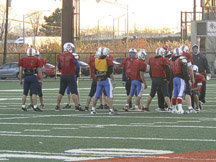A gridiron drama that unfolded in Pittsburgh nearly two years ago still holds dangerous lessons for student athletes and Little League players nationwide, including right here in Hudson County.
In 2009, Pittsburgh Steelers star quarterback Ben Roethlisberger sat out a critical game against the rival Baltimore Ravens due to a concussion. Backup quarterback Dennis Dixon filled in for Big Ben, and late in the game threw an interception that cost the Steelers a win when the Ravens narrowly defeated Pittsburgh 20 to 17.
In 2008, a football player at Montclair High School died of a brain hemorrhage after sustaining a concussion on the practice field.
____________
But doctors don’t like that idea.
“The message we’re sending to college and high school athletes is that you should play with a concussion, which is not what is recommended,” said Sean Lager, M.D., who specializes in orthopedic and sports medicine. “Everyone understands if you tear your ACL [a crucial knee ligament] on the field, you are not playing that game. You are not playing that week. You are not playing that season. Your ACL can be surgically repaired and you can play again. But if you play with a concussion and have another one and have post-concussion syndrome, I can’t help you.”
Lager founded the Jersey City-based Cleared to Play, a nonprofit dedicated to treating concussions and educating the public about their dangers. The organization, which Lager runs with colleague Orlando Gonzalez, M.D., is currently focused on treating and preventing concussions in students in Hudson and Bergen counties.
‘Confused, dazed’
According to Lager, over the last five years there has been a growing awareness within the athletic community around the short and long-term impact of concussions, particularly their impact on young athletes whose brains are still developing.
“An immature brain is more susceptible to repeat injury [from a concussion],” said Lager.
A concussion, Lager noted, can result from various causes. Athletes can get a concussion by hitting their heads, or by running at a high rate of speed then coming to an abrupt stop. Concussed players may or may not lose consciousness, but their sense of awareness is affected.
“There’s a period where you’re confused or dazed, or you can’t remember the events that just occurred,” said Lager.
Although deaths from sports-related concussions are rare, they aren’t unheard of. In 2008, Ryne Dougherty, a football player at Montclair High School, died of a brain hemorrhage after sustaining a concussion on the practice field.
But one needn’t be a burly rugby player to get a concussion. Lager said that, among students, some of the highest rates of concussions happen to cheerleaders and girls soccer players.
State law takes them out of game
Last year Gov. Christopher Christie signed a law that requires student athletes to be immediately taken out of play when they sustain a concussion. These students are not allowed to return to sports activities until they’ve been examined by a doctor trained in the treatment of concussions. That doctor must give the student clearance to return to the playing field.
The law signed by the governor, officially known as the New Jersey Comprehensive Concussion Safety Law, also requires school districts throughout the state to adopt policies to educate and train their staff regarding the diagnosis and treatment of concussions.
To better protect athletes from death and long-term brain injury, the National Football League (NFL), National Hockey League (NHL), and other professional and scholastic athletic leagues now recommend that athletes be given baseline cognitive-function tests before they even step onto the field.
These baseline tests measure an athlete’s normal brain function during the off-season. Should the athlete sustain a concussion during their sports activity, the brain function test is given again.
The results of the two tests are then compared to determine the extent of the injury. Tests are repeated periodically post-injury to determine when the brain has returned to its normal functioning level.
School districts are now beginning to test their athletes in the preseason so there’s comparative data that can be used if the student gets hurt playing sports.
Working with school districts throughout Hudson and Bergen counties, Cleared to Play hopes to do baseline, preseason testing to 6,500 to 7,000 student athletes this school year – at no cost to the students or the school districts. As a nonprofit, the baseline testing through Cleared to Play is covered through donations. If a student gets a concussion on the field, the family can then have post-injury testing done by trained doctors. Post injury testing is typically covered by medical insurance, Lager said.
He encouraged parents of athletes to have both pre- and post-injury testing done by trained physicians who specialize in the treatment of concussions.
Cleared to Play uses the ImPact test, which was developed at the University of Pittsburgh and is used by the NFL and NHL. ImPact – which requires students to answer several questions on a computer – is only one tool used in the diagnosis of a concussion, said Lager. Students suspected of having a concussion still need a medical exam by a doctor and should also have a head CT (cranial computed tomography).
Earlier this month several students from across Hudson County took their baseline tests at Union City High School. A spokeswoman for the Jersey City Board of Education has last week the district has yet to decide who will do baseline testing for the schools this academic year.
E-mail E. Assata Wright at awright@hudsonreporter.com.
